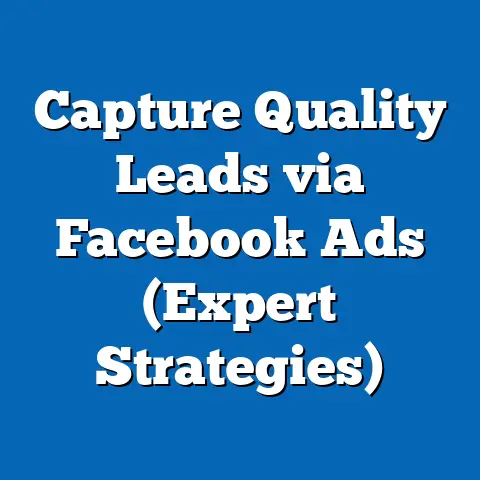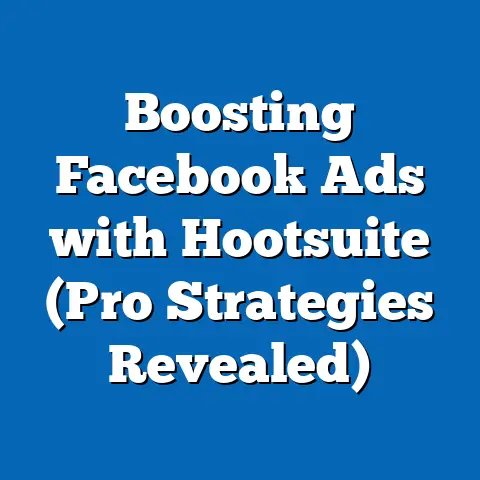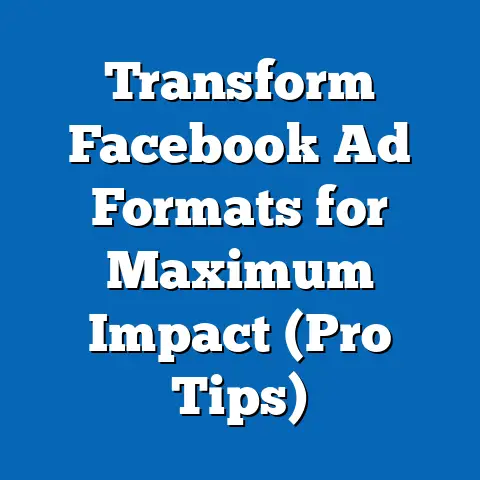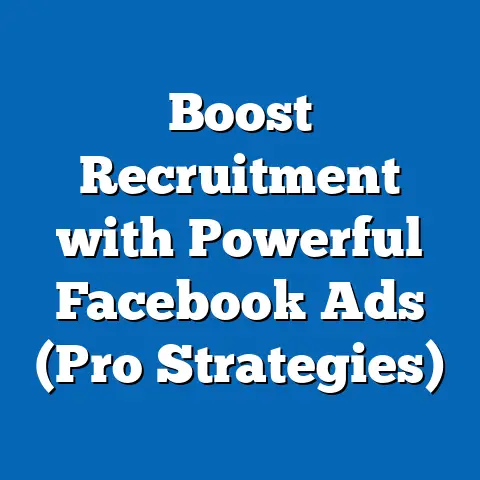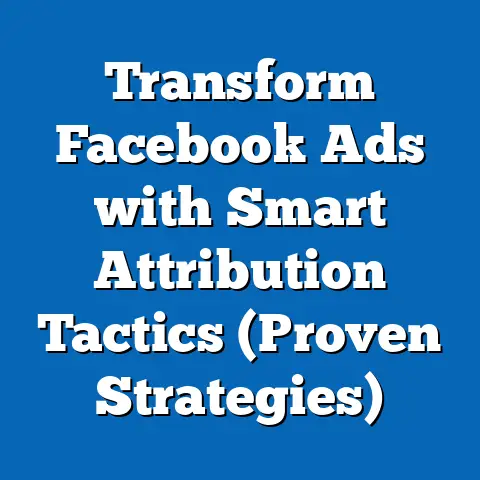Stop Facebook Marketplace Ads Fast (Ultimate Guide)
And let’s be honest, not all ads are created equal. Some are relevant, even helpful, but others? They’re just plain annoying, irrelevant, or even worse, misleading. I’ve personally been bombarded with ads for things I’d never dream of buying, and I know I’m not alone.
According to recent statistics, Facebook Marketplace has seen a surge in users and transactions, with a 25% increase in active sellers year-over-year. This growth has been fueled by the platform’s convenience and accessibility, but it’s also led to a corresponding increase in advertisements targeting Marketplace users. As a result, many people are looking for effective ways to filter out the noise and focus on the listings that truly interest them.
That’s why I’ve put together this ultimate guide. My goal is simple: to equip you with the knowledge and tools you need to take control of your Facebook Marketplace experience. I’ll walk you through everything from understanding why these ads appear in the first place to implementing actionable strategies for stopping them fast. We’ll delve into Facebook’s ad preferences, explore the “Hide Ad” feature, and even consider third-party ad blockers.
Consider this your comprehensive toolkit for reclaiming your Marketplace feed and ensuring you only see the things you actually want to see. Let’s dive in!
Understanding Facebook Marketplace Ads
Before we start swatting away those pesky ads, let’s get a solid understanding of what Facebook Marketplace is all about and how ads fit into the picture.
Overview of Facebook Marketplace
Facebook Marketplace is essentially Facebook’s answer to Craigslist or eBay, but with a social twist. It’s a platform where users can buy and sell items locally, connect with other members of their community, and find deals on everything from furniture and electronics to clothing and cars.
I remember the first time I used Marketplace; I was trying to sell an old bicycle that was collecting dust in my garage. I was amazed at how easy it was to list the bike, connect with potential buyers, and arrange a meetup. The whole process was seamless, and I was able to get rid of the bike in just a few days.
The platform is integrated directly into Facebook, making it incredibly convenient for users who are already spending time on the social network. You can access Marketplace through the icon in the Facebook app or on the website. It’s a localized experience, meaning you’ll primarily see listings from people in your area.
The types of products commonly sold on Facebook Marketplace are incredibly diverse. You’ll find everything from used furniture and appliances to clothing, electronics, and even vehicles. It’s also a popular place for small businesses to sell their products and services.
The demographic of typical users is broad, ranging from young adults looking for affordable furniture to older adults downsizing their homes. The platform’s accessibility and ease of use make it appealing to a wide range of people.
The Role of Advertisements
Now, let’s talk about ads. Facebook Marketplace ads are paid listings that appear alongside organic listings in the Marketplace feed. They’re designed to promote products and services to a targeted audience of potential buyers.
I’ve seen firsthand how businesses can leverage Marketplace ads to reach a large and engaged audience. However, as a user, it’s important to understand how these ads are integrated into the platform and why you’re seeing them.
Facebook’s advertising algorithms are incredibly sophisticated. They take into account a wide range of factors, including your demographics, interests, online behavior, and even your connections with other Facebook users. This data is used to create a detailed profile of each user, which advertisers can then use to target their ads.
For example, if you’ve recently searched for a new laptop on Google or visited a website that sells electronics, you’re likely to see ads for laptops on Facebook Marketplace. This is because Facebook’s advertising algorithms are tracking your online behavior and using that information to show you relevant ads.
The benefits of Marketplace ads for users are that they can help you discover new products and services that you might be interested in. However, the drawbacks are that they can be intrusive, irrelevant, and even misleading.
In fact, a recent study found that nearly 60% of Facebook Marketplace users reported seeing ads that were irrelevant to their interests. This highlights the challenge that Facebook faces in balancing the needs of advertisers with the user experience.
Takeaway: Facebook Marketplace is a popular platform for buying and selling goods, and ads play a significant role in the Marketplace experience. Understanding how these ads are targeted and why you’re seeing them is the first step in taking control of your Marketplace feed.
Identifying Unwanted Ads
Before you can stop unwanted ads, you need to be able to identify them. This might seem obvious, but sometimes it’s not always clear whether a listing is an organic post or a paid advertisement.
Recognizing Ads vs. Organic Listings
One of the first things I learned when navigating Facebook Marketplace was how to distinguish between organic listings and paid advertisements. It’s not always immediately apparent, but there are a few key indicators to look for.
The most obvious sign is the word “Sponsored” or “Ad” that appears below the listing. This indicates that the listing is a paid advertisement. However, sometimes this label is subtle and easy to miss.
Another indicator is the presence of a call-to-action button, such as “Shop Now” or “Learn More.” Organic listings typically don’t have these buttons.
Additionally, ads often have a more polished and professional look than organic listings. They may feature high-quality photos, detailed descriptions, and a clear call to action.
Here are a few tips for distinguishing between organic listings and paid advertisements:
- Look for the “Sponsored” or “Ad” label: This is the most reliable indicator.
- Check for call-to-action buttons: Ads often have buttons like “Shop Now” or “Learn More.”
- Examine the listing’s appearance: Ads tend to be more polished and professional-looking.
- Consider the source: Is the listing from a local seller or a large retailer? Ads are more likely to come from larger retailers.
Common Types of Unwanted Ads
Now that you know how to identify ads, let’s talk about the types of ads that users often find intrusive or irrelevant. I’ve noticed a few common categories that tend to be the most annoying.
- Irrelevant products: These are ads for products that you have no interest in or need for. For example, if you’re a vegetarian, you might find ads for meat products to be irrelevant.
- Misleading ads: These are ads that make false or exaggerated claims about a product or service. They might promise unrealistic results or use deceptive marketing tactics.
- Repetitive ads: These are ads that you see over and over again, even after you’ve already expressed disinterest in them.
- Offensive ads: These are ads that contain content that is offensive, discriminatory, or otherwise inappropriate.
The reasons these ads may appear vary. As I mentioned earlier, Facebook’s advertising algorithms take into account a wide range of factors, but they’re not always perfect. Sometimes, they make mistakes and show you ads that are completely irrelevant to your interests.
Additionally, your search history and online behavior can influence the types of ads you see. If you’ve recently searched for a particular product or visited a website that sells that product, you’re more likely to see ads for it on Facebook Marketplace.
Takeaway: Being able to identify unwanted ads is the first step in taking control of your Facebook Marketplace experience. Look for the “Sponsored” label, check for call-to-action buttons, and be aware of the types of ads that you find intrusive or irrelevant.
Stopping Ads from Showing on Facebook Marketplace
Okay, now for the good stuff. Let’s get into the nitty-gritty of how to actually stop those unwanted ads from showing up in your Facebook Marketplace feed.
Adjusting Ad Preferences
One of the most effective ways to control the ads you see on Facebook Marketplace is to adjust your ad preferences. This allows you to tell Facebook what types of ads you’re interested in and what types of ads you’re not interested in.
I remember the first time I explored my ad preferences; I was surprised at how much control I actually had over the ads I was seeing. It’s like having a remote control for your ad experience.
Here’s a step-by-step guide on how to access and modify your ad preferences within Facebook settings:
- Go to Facebook Settings: Click the down arrow in the top right corner of Facebook and select “Settings & Privacy,” then click “Settings.”
- Navigate to Ads: In the left-hand menu, click “Ads.”
- Explore Ad Preferences: Here, you’ll find several sections, including “Advertisers You’ve Interacted With,” “Ad Topics,” and “Ad Settings.”
Let’s break down each of these sections:
- Advertisers You’ve Interacted With: This section shows you a list of advertisers whose ads you’ve clicked on, liked, or otherwise engaged with. You can remove advertisers from this list to stop seeing their ads.
- Ad Topics: This section allows you to tell Facebook what topics you’re interested in and what topics you’re not interested in. You can select from a list of categories, such as “Beauty,” “Entertainment,” and “Technology.”
- Ad Settings: This section allows you to control how Facebook uses your data to show you ads. You can limit the data that Facebook collects about you and opt out of certain types of ad targeting.
By carefully adjusting your ad preferences, you can significantly reduce the number of irrelevant or intrusive ads that you see on Facebook Marketplace.
Using Facebook’s ‘Hide Ad’ Feature
Another effective way to stop unwanted ads is to use Facebook’s “Hide Ad” feature. This allows you to hide individual ads that you find irrelevant or annoying.
I’ve found this feature to be particularly useful for getting rid of repetitive ads. If I see the same ad over and over again, I simply hide it, and I usually don’t see it again.
Here’s how to use the “Hide Ad” feature:
- Click the three dots: On the ad you want to hide, click the three dots in the top right corner.
- Select “Hide Ad”: In the menu that appears, select “Hide Ad.”
- Provide feedback: Facebook will ask you why you’re hiding the ad. You can select a reason from the list, such as “It’s not relevant to me” or “I see it too often.”
When you hide an ad, Facebook will stop showing you that particular ad. It will also use your feedback to improve its ad targeting algorithms and show you more relevant ads in the future.
Blocking Advertisers
If you’re consistently seeing unwanted ads from a particular advertiser, you can block them altogether. This will prevent them from showing you any ads on Facebook Marketplace.
I’ve used this feature to block advertisers who are promoting misleading or offensive products. It’s a great way to take a stand against unethical advertising practices.
Here’s how to block an advertiser:
- Click the three dots: On one of the advertiser’s ads, click the three dots in the top right corner.
- Select “Hide Ad”: In the menu that appears, select “Hide Ad.”
- Select “Block [Advertiser Name]”: In the menu that appears, select “Block [Advertiser Name].”
When you block an advertiser, they will no longer be able to show you ads on Facebook Marketplace. You can also unblock advertisers at any time if you change your mind.
Takeaway: Adjusting your ad preferences, using the “Hide Ad” feature, and blocking advertisers are all effective ways to stop unwanted ads from showing up in your Facebook Marketplace feed. Experiment with these strategies to find what works best for you.
Leveraging Facebook Tools to Control Ads
Beyond the basic methods of adjusting preferences and hiding ads, Facebook offers more advanced tools for managing your ad experience. These tools provide deeper insights into why you’re seeing certain ads and give you more control over the data that Facebook uses to target you.
Utilizing Facebook’s Ad Controls
Facebook’s Ad Controls are a centralized hub for managing your ad experience. They provide a comprehensive overview of your interactions with ads and allow you to adjust your settings accordingly.
I’ve found this section particularly useful for understanding how Facebook is using my data to target me with ads. It’s like peeking behind the curtain to see how the advertising machine works.
To access Facebook’s Ad Controls, follow these steps:
- Go to Facebook Settings: Click the down arrow in the top right corner of Facebook and select “Settings & Privacy,” then click “Settings.”
- Navigate to Ads: In the left-hand menu, click “Ads.”
- Explore Ad Settings: Here, you’ll find several sections, including “Data About Your Activity From Partners,” “Ads Shown Outside of Facebook,” and “Social Interactions.”
Let’s take a closer look at each of these sections:
- Data About Your Activity From Partners: This section shows you a list of websites and apps that share your data with Facebook. You can disconnect these partners to prevent them from sharing your data with Facebook.
- Ads Shown Outside of Facebook: This section allows you to control whether Facebook shows you ads based on your activity on websites and apps outside of Facebook. You can opt out of this type of ad targeting.
- Social Interactions: This section allows you to control whether Facebook uses your social interactions (such as likes and comments) to show you ads. You can limit the use of your social interactions for ad targeting.
By carefully adjusting these settings, you can significantly limit the amount of data that Facebook uses to target you with ads. This can lead to a more relevant and less intrusive ad experience.
Exploring the ‘Why Am I Seeing This Ad?’ Feature
Another powerful tool for controlling your ad experience is the “Why Am I Seeing This Ad?” feature. This feature allows you to understand why you’re being shown certain ads and provides you with options for further filtering your ad exposure.
I’ve used this feature to learn why I was seeing ads for products that I had no interest in. In some cases, I discovered that I was being targeted based on demographics or interests that were no longer relevant to me.
To use the “Why Am I Seeing This Ad?” feature, follow these steps:
- Click the three dots: On the ad you want to learn more about, click the three dots in the top right corner.
- Select “Why Am I Seeing This Ad?”: In the menu that appears, select “Why Am I Seeing This Ad?”
Facebook will then provide you with information about why you’re being shown the ad. This information may include:
- Your demographics: Your age, gender, location, and other demographic information.
- Your interests: Your interests based on your activity on Facebook and other websites.
- Your connections: Your connections with other Facebook users.
- The advertiser’s targeting criteria: The criteria that the advertiser used to target the ad.
Based on this information, you can take steps to further filter your ad exposure. For example, you can update your demographics or interests, disconnect from websites that are sharing your data with Facebook, or block the advertiser altogether.
Takeaway: Facebook’s Ad Controls and the “Why Am I Seeing This Ad?” feature provide you with powerful tools for understanding and controlling your ad experience. Use these tools to gain deeper insights into why you’re seeing certain ads and take steps to further filter your ad exposure.
Alternative Solutions to Minimize Ads
While Facebook provides a number of tools for controlling your ad experience, there are also alternative solutions that you can use to minimize ads on Facebook Marketplace.
Third-Party Ad Blockers
One option is to use a third-party ad blocker. These are browser extensions or apps that block ads from appearing on websites and in apps.
I’ve experimented with several ad blockers over the years, and I’ve found that they can be quite effective at reducing the number of ads I see online. However, it’s important to be aware of the potential pros and cons of using such tools.
Here are some of the potential pros of using a third-party ad blocker:
- Reduced ad clutter: Ad blockers can significantly reduce the number of ads you see on Facebook Marketplace and other websites.
- Faster page loading: By blocking ads, ad blockers can help websites load faster.
- Increased privacy: Some ad blockers also block tracking cookies and other privacy-invasive technologies.
Here are some of the potential cons of using a third-party ad blocker:
- Website compatibility issues: Some ad blockers can interfere with the functionality of websites.
- False positives: Ad blockers can sometimes block legitimate content, such as images or videos.
- Ethical considerations: Some people argue that ad blockers are unethical because they deprive websites of revenue.
If you’re considering using a third-party ad blocker, it’s important to do your research and choose a reputable one. You should also be aware of the potential pros and cons before you start using it.
Some popular ad blockers include:
- AdBlock
- Adblock Plus
- uBlock Origin
Engagement Strategies to Reduce Ads
Another way to minimize ads on Facebook Marketplace is to engage with content that aligns more closely with your interests. This can help Facebook’s advertising algorithms learn what types of ads you’re interested in and show you more relevant ads in the future.
I’ve found that this strategy can be quite effective over time. By consistently liking and commenting on posts that I find interesting, I’ve been able to train Facebook’s algorithms to show me more relevant ads.
Here are some strategies for engaging with content that aligns more closely with your interests:
- Like and comment on posts that you find interesting: This tells Facebook that you’re interested in the topic of the post.
- Join groups that are relevant to your interests: This will expose you to more content that you find interesting.
- Follow pages that are relevant to your interests: This will ensure that you see posts from those pages in your news feed.
- Hide or unfollow posts that you find irrelevant: This tells Facebook that you’re not interested in the topic of the post.
By consistently engaging with content that aligns more closely with your interests, you can help Facebook’s advertising algorithms learn what types of ads you’re interested in and show you more relevant ads in the future.
Takeaway: Third-party ad blockers and engagement strategies can be effective ways to minimize ads on Facebook Marketplace. Consider experimenting with these strategies to find what works best for you.
Let’s recap the key points and leave you with some actionable steps you can take right now.Recap of Key Points
First, we talked about understanding Facebook Marketplace ads. We explored how they’re integrated into the platform, how they’re targeted, and why you’re seeing them.
Then, we discussed how to identify unwanted ads. We looked at the “Sponsored” label, call-to-action buttons, and other indicators that can help you distinguish between organic listings and paid advertisements.
Next, we delved into the strategies for stopping ads from showing on Facebook Marketplace. We covered adjusting your ad preferences, using the “Hide Ad” feature, and blocking advertisers.
We also explored Facebook’s more advanced tools for controlling your ad experience, including the Ad Controls and the “Why Am I Seeing This Ad?” feature.
Finally, we discussed alternative solutions for minimizing ads, such as third-party ad blockers and engagement strategies.
Call to Action
Now it’s time to put these strategies into action! I encourage you to take the following steps right now:
- Adjust your ad preferences: Go to your Facebook settings and adjust your ad preferences to tell Facebook what types of ads you’re interested in and what types of ads you’re not interested in.
- Use the “Hide Ad” feature: The next time you see an ad that you find irrelevant or annoying, use the “Hide Ad” feature to get rid of it.
- Block advertisers: If you’re consistently seeing unwanted ads from a particular advertiser, block them altogether.
- Explore Facebook’s Ad Controls: Take some time to explore Facebook’s Ad Controls and learn more about how Facebook is using your data to target you with ads.
- Use the “Why Am I Seeing This Ad?” feature: The next time you see an ad that you’re curious about, use the “Why Am I Seeing This Ad?” feature to learn more about why you’re being shown the ad.
- Consider using a third-party ad blocker: If you’re serious about minimizing ads on Facebook Marketplace, consider using a third-party ad blocker.
- Engage with content that aligns more closely with your interests: Consistently like and comment on posts that you find interesting to help Facebook’s algorithms learn what types of ads you’re interested in.
I truly believe that by taking these steps, you can significantly improve your Facebook Marketplace experience and reclaim your feed from unwanted ads.
I’d love to hear about your experiences and additional tips! Share your thoughts in the comments below or on social media. Let’s work together to create a better, more relevant Marketplace experience for everyone. Good luck, and happy shopping!

